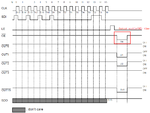agent5
Newbie level 5
Hi folks, I am doing a LED scrolling message board and need some help over here.
After searching here and there, I still have some doubts that need some further explanation.
Basically the schematic are similar.
References:
**broken link removed**
I am still at building hardware stage and wish to display some character first without scrolling.
Quite a lot doubts here so please bear with me.
Intro
I am going to state what I understand on how a LED scrolling message board work (hardware) before proceeding cause if I got the big idea wrong no point going any further ..
After receiving data, the AT89S51 will translate those data into highs/lows and by controlling other components with those highs/lows, character is being displayed (scrolled).
Below are the functions (my understanding so far) of each component made up the board.
Remarks:
I don’t ask too much from you guys but if you see some fatal misconception please tell me.
Of course, I will appreciate greatly for some heads-up and reference.
Microcontroller AT89S51
No, I don’t know how it receives data and “translate” it in to display.
What I do know is, I need some pins to send a high/low as an input to decoder / shift register and ultimately lights up some LED. That’s it.
Shift Register: NXP 74HC595N
Shift Register translates serial input to parallel output.
Exp: DS received 8 bits and output those 8 bits at once through the 8 output pins.
The most common word I see on this topic about Shift Register is drive. Like “Shift Register is used to drive the LED”. But I am not so sure what does it mean.
Current Sinker: Toshiba ULN2803APG
8 inputs / 8 outputs
According to the logic below, a high input will give a low at output.
Low will give a low as well.
The output is connected to the cathode of the LED.
I don’t get the sinker part. What does it sinking and how the sinking happen? Some says its sourcing current, but sinker? Moreover, it dosnt work like what it suppose too, for the case when input is low that fine. But when a high (~5V) is apply at input, the output is around 0.6V but not 0V.
**broken link removed**
Dot Matrix LED: 8X8 Common Cathode
**broken link removed**
All anode are connected at the same row
All cathode are connected at the same column
Anodes are connected to AT89S51 while Cathode to Current sinker.
3 – 8 Decoder: Philips 74HC259N
For controlling 8 lines with only 3 pins.
Thanks !!
After searching here and there, I still have some doubts that need some further explanation.
Basically the schematic are similar.
References:
- https://www.edaboard.com/threads/11364/
- http://jumptuck.com/2011/11/02/how-shift-registers-work/
- http://www.electronics-lab.com/projects/misc/013/index.html
- http://silent.org.pl/home/2010/09/26/w-budowie-matryca-led-64x16/comment-page-1/#comment-17827
**broken link removed**
I am still at building hardware stage and wish to display some character first without scrolling.
Quite a lot doubts here so please bear with me.
Intro
I am going to state what I understand on how a LED scrolling message board work (hardware) before proceeding cause if I got the big idea wrong no point going any further ..
After receiving data, the AT89S51 will translate those data into highs/lows and by controlling other components with those highs/lows, character is being displayed (scrolled).
Below are the functions (my understanding so far) of each component made up the board.
Remarks:
I don’t ask too much from you guys but if you see some fatal misconception please tell me.
Of course, I will appreciate greatly for some heads-up and reference.
Microcontroller AT89S51
No, I don’t know how it receives data and “translate” it in to display.
What I do know is, I need some pins to send a high/low as an input to decoder / shift register and ultimately lights up some LED. That’s it.
Shift Register: NXP 74HC595N
Shift Register translates serial input to parallel output.
Exp: DS received 8 bits and output those 8 bits at once through the 8 output pins.
The most common word I see on this topic about Shift Register is drive. Like “Shift Register is used to drive the LED”. But I am not so sure what does it mean.
Current Sinker: Toshiba ULN2803APG
8 inputs / 8 outputs
According to the logic below, a high input will give a low at output.
Low will give a low as well.
The output is connected to the cathode of the LED.
I don’t get the sinker part. What does it sinking and how the sinking happen? Some says its sourcing current, but sinker? Moreover, it dosnt work like what it suppose too, for the case when input is low that fine. But when a high (~5V) is apply at input, the output is around 0.6V but not 0V.
**broken link removed**
Dot Matrix LED: 8X8 Common Cathode
**broken link removed**
All anode are connected at the same row
All cathode are connected at the same column
Anodes are connected to AT89S51 while Cathode to Current sinker.
3 – 8 Decoder: Philips 74HC259N
For controlling 8 lines with only 3 pins.
Thanks !!




